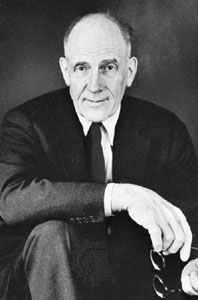
Wallace Kirkman Harrison was an American architect. Harrison started his professional career with the firm of Corbett, Harrison & MacMurray, participating in the construction of Rockefeller Center. He is best known for executing large public projects in New York City and upstate, many of them a result of his long and fruitful personal relationship with Nelson Rockefeller, for whom he served as an adviser.
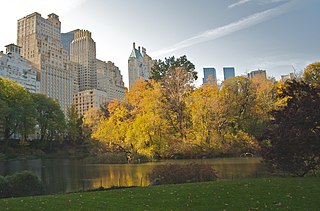
An apartment, or flat, is a self-contained housing unit that occupies part of a building, generally on a single story. There are many names for these overall buildings, see below. The housing tenure of apartments also varies considerably, from large-scale public housing, to owner occupancy within what is legally a condominium, to tenants renting from a private landlord.

Downtown Cleveland is the central business district of Cleveland, Ohio. The economic and symbolic center of the city and the Cleveland-Akron-Canton, OH Combined Statistical Area, it is Cleveland's oldest district, with its Public Square laid out by city founder General Moses Cleaveland in 1796. Downtown's diverse architecture includes the Cleveland Mall, one of the most complete examples of City Beautiful design in the United States.
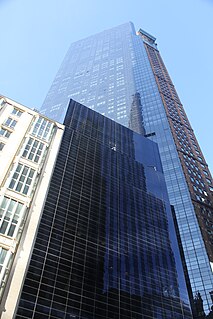
Metropolitan Tower is a mixed-use skyscraper at 146 West 57th Street in the Midtown Manhattan neighborhood of New York City. Completed in 1987 and designed by SLCE Architects, the building measures 716 ft (218 m) tall with 68 stories. Metropolitan Tower is designed with a black-glass facade, with a rectangular 18-story base topped by a 48-story triangular tower. It was developed by Harry Macklowe.

Tudor City is an apartment complex located on the southern edge of Turtle Bay on the East Side of Manhattan in New York City, near Turtle Bay's border with Murray Hill. It lies on a low cliff, which is east of Second Avenue between 40th and 43rd Streets and overlooks First Avenue. Construction commenced in 1926, making it the first residential skyscraper complex in the world.

Lafayette Park is a historic urban renewal district east of Downtown Detroit and contains the largest collection of residential buildings designed by Ludwig Mies van der Rohe. The northern section planned and partially built by Mies is listed in the National Register of Historic Places. In 2015 it was designated a National Historic Landmark District. Lafayette Park is located on the city's lower east side directly south of the Eastern Market Historic District. In general, the neighborhood, including portions developed by other architects, has been regarded as an incubator of progressive architecture and one of the few historically stable urban renewal zones in the United States.

57th Street is a broad thoroughfare in the New York City borough of Manhattan, one of the major two-way, east-west streets in the borough's grid. As with Manhattan's other "crosstown" streets, it is divided into its east and west sections at Fifth Avenue. The street runs from a small park overlooking the East River in the east to the West Side Highway along the Hudson River in the west. 57th Street runs through the neighborhoods of Sutton Place, Midtown Manhattan, and Hell's Kitchen from east to west.
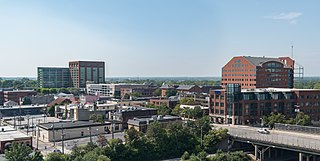
The Brewery District, traditionally known as the Old German Brewing District, is a neighborhood located in Columbus, Ohio. Located just south of the central business district and west of German Village, it is bounded by Interstate 70 on the north, South Pearl Street on the east, Greenlawn Avenue on the south, and the Scioto River on the west.

Frederick William ("Fred") Anhalt was a builder and contractor who constructed many distinguished rental apartment buildings in Seattle, Washington in the 1920s and early 1930s. In 1993, the Seattle Chapter of the American Institute of Architects (AIA) awarded Anhalt an honorary membership in recognition of excellence in residential design. In 2001, The Seattle Times listed Anhalt as one of the 150 most influential people in Seattle History His buildings have been referred to as "Castles in Seattle."

The Alwyn Court, also known as The Alwyn, is an apartment building at 180 West 58th Street, at the southeast corner with Seventh Avenue, in the Midtown Manhattan neighborhood of New York City. The Alwyn Court was built between 1907 and 1909 and was designed by Harde & Short in the French Renaissance style. It is one of several luxury developments constructed along Seventh Avenue during the late 19th and early 20th century.

The East Jefferson Avenue Residential District in Detroit, Michigan, includes the Thematic Resource (TR) in the multiple property submission to the National Register of Historic Places which was approved on October 9, 1985. The structures are single-family and multiple-unit residential buildings with construction dates spanning nearly a century, from 1835 to 1931. The area is located on the lower east side of the city.

The Bergen Section of Jersey City, New Jersey is the neighborhood on either side of Kennedy Boulevard between Saint Peter's College/ McGinley Square and Communipaw Avenue in the Bergen-Lafayette section of the city. The name Bergen, used throughout Hudson County, is taken from the original Bergen, New Netherland settlement at Bergen Square.

The Osborne, also known as the Osborne Apartments or 205 West 57th Street, is an apartment building at Seventh Avenue and 57th Street in Midtown Manhattan in New York City. The Osborne was originally designed by James Edward Ware and constructed from 1883 to 1885. An annex to the west, designed by Alfred S. G. Taylor and Julien Clarence Levi, was constructed in 1906. The Osborne is the second oldest luxury apartment building in New York City, behind the Dakota.
8 Spruce Street, previously known as the Beekman Tower and New York by Gehry, is a 76-story skyscraper designed by architect Frank Gehry at 8 Spruce Street in the Financial District of Manhattan, New York City.

737 Park Avenue is a prewar residential building on the Upper East Side of Manhattan, United States. Initially, the building had more than 100 apartments. The current capacity after renovation is 60 apartments.

998 Fifth Avenue is a luxury cooperative on the Upper East Side of Manhattan, New York City located on Fifth Avenue at the northeast corner of East 81st Street.
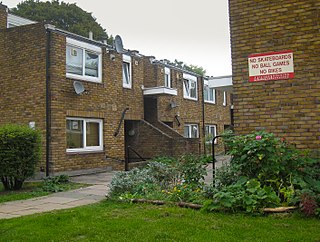
Cressingham Gardens is a council garden estate in Lambeth. It is located on the southern edge of Brockwell Park. It comprises 306 dwellings, a mixture of four, three and two-bedroom houses, and one-bedroom apartments. It was designed at the end of the 1960s by the Lambeth Borough Council Architect Edward Hollamby and second architect Roger Westman, and built at the start of the 1970s. In 2012 Lambeth Council proposed demolishing the estate, to replace the terraced houses by apartment blocks. Most of the apartments would then be for sale to the private sector. The residents, those in Lambeth who wish to prevent the gentrification of the borough, and those who want to conserve what they believe to be important architectural heritage, are campaigning to prevent its demolition.

655 Park Avenue is a Georgian-style co-op residential building on Manhattan's Upper East Side, located on Park Avenue between 67th Street and 68th Street, adjacent to the Park Avenue Armory. It was developed in 1924 by Dwight P. Robinson & Company. The building at 655 Park Avenue was designed by architects James Edwin Ruthven Carpenter, Jr., often referred to by the initials "J.E.R. Carpenter", and Mott B. Schmidt. Carpenter is considered the leading architect for luxury residential high-rise buildings in New York City in the early 1900s, while Schmidt is known for his buildings in the American Georgian Classical style, including Sutton Place and houses for New York City's society figures and business elite.

The Gainsborough Studios, also known as 222 Central Park South, is a residential building on Central Park South, just east of Columbus Circle, in Midtown Manhattan, New York City. Designed by Charles W. Buckham, the building is 16 stories tall with 34 apartments. Named after English painter Thomas Gainsborough, the building is one of several in Manhattan that were built in the early 20th century as both studios and residences for artists.

500 Park Avenue is an office and condominium building on the southwest corner of Park Avenue and 59th Street in the Midtown Manhattan neighborhood of New York City, composed of the 11-story Pepsi-Cola Building and the 40-story 500 Park Tower. The original Pepsi-Cola Building along Park Avenue was constructed from 1958 to 1960 and designed by Gordon Bunshaft and Natalie de Blois of Skidmore, Owings and Merrill (SOM). The tower along 59th Street was constructed between 1981 and 1984 to designs by James Stewart Polshek & Partners.



















